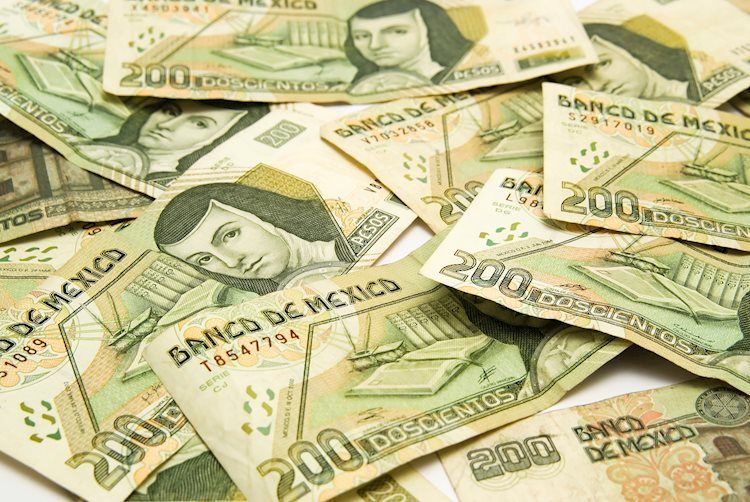- Mexican Peso gains although Retail Sales declined for the fourth consecutive month.
- A gloomy economic outlook for Mexico pressures the Bank of Mexico to cut rates at the upcoming meeting.
- IMF revises Mexico’s 2024 growth forecast to 1.5%, widening the divergence with the US, projected to grow at 2.8%.
- Traders eye Mexican mid-month inflation data, Fed speakers later this week to sway the direction of USD/MXN.
The Mexican Peso stages a comeback against the US Dollar on Wednesday, after further data revealed the economy continues to underperform, which could push the Bank of Mexico (Banxico) to lower borrowing costs at the upcoming meeting. At the time of writing, the USD/MXN trades at 19.88. down 0.33%.
Mexico’s National Statistics Agency, known as INEGI, revealed that monthly August Retail Sales were lower than expected, while annual basis figures plunged for the fourth straight month. Wednesday’s data, along with the contraction of the Economic Activity Index, paint a gloomy scenario for the new administration of President Claudia Sheinbaum.
Ahead of the week, October mid-month inflation data is expected on Thursday. Estimates suggest that headline inflation would drop from 4.66% to 4.65%, while the underlying inflation is projected to fall from 3.95% to 3.82%.
Last week, the International Monetary Fund (IMF) projected the Mexican economy will grow 1.5% in 2024, lower than in its previous forecast. In its annual report, the IMF estimates a widening divergence between the economies of Mexico and the US, with the former expected to grow at a 2.8% pace, while the latter deepens its economic slowdown. For 2025, Mexico is projected to grow 1.3%, while the US economy is foreseen growing at a 2.2% pace.
On the US front, the economic schedule featured housing data for September, which missed projections. In the meantime, Federal Reserve (Fed) speakers will continue to cross the wires.
San Francisco Fed President Mary Daly favors further adjustments to the fed funds rate, saying the central bank will remain data-dependent and that she hasn’t seen anything that would suggest pausing the rate cutting.
Meanwhile, Kansas City Fed President Jeffrey Schmid adopted a more cautious stance, adding that he prefers to avoid outsized rate cuts, noting that they’re seeing a normalization of the labor market rather than a deterioration.
Ahead this week, Mexico’s economic schedule will be featuring the release of Mid-Month Inflation for October. In the US, Fed speakers, jobs data, and S&P Global Flash PMIs should influence the direction of USD/MXN.
Daily digest market movers: Mexican Peso climbs, shrugs off economic slowdown
- Mexico’s Retail Sales dipped to 0.1% MoM, below the 0.2% expansion foreseen by analysts and July’s 0.7% increase.
- On an annual basis, Retail Sales plummeted -0.8%, below estimates of -0.4% and the previous month of -0.6%.
- A Reuters poll showed most economists expect headline prices to rise while core prices decrease in the first half of October.
- If Mexico’s inflation dips further, the Bank of Mexico (Banxico) will likely lower rates at the upcoming November 14 meeting.
- Data from the Chicago Board of Trade, via the December fed funds rate futures contract, shows investors estimate 48 bps of Fed easing by the end of the year.
USD/MXN technical outlook: Mexican Peso appreciates though remains tilted to the downside
The USD/MXN remains upwardly biased despite retreating below the 20.00 figure. Momentum shows that bulls remain in charge with the Relative Strength Index (RSI) above its 50 neutral line despite aiming lower.
If USD/MXN clears the 20.00 figure, the next resistance would be the September 5 high at 20.14 and the year-to-date (YTD) high at 20.22. On further strength, the next stop would be 20.50, ahead of 21.00.
Conversely, if the USD/MXN extends its losses below the October 18 low of 19.64, a test of the October 10 daily peak at 19.61 is on the cards. Next would be the October 4 swing low of 19.10 before testing 19.00.
Banxico FAQs
The Bank of Mexico, also known as Banxico, is the country’s central bank. Its mission is to preserve the value of Mexico’s currency, the Mexican Peso (MXN), and to set the monetary policy. To this end, its main objective is to maintain low and stable inflation within target levels – at or close to its target of 3%, the midpoint in a tolerance band of between 2% and 4%.
The main tool of the Banxico to guide monetary policy is by setting interest rates. When inflation is above target, the bank will attempt to tame it by raising rates, making it more expensive for households and businesses to borrow money and thus cooling the economy. Higher interest rates are generally positive for the Mexican Peso (MXN) as they lead to higher yields, making the country a more attractive place for investors. On the contrary, lower interest rates tend to weaken MXN. The rate differential with the USD, or how the Banxico is expected to set interest rates compared with the US Federal Reserve (Fed), is a key factor.
Banxico meets eight times a year, and its monetary policy is greatly influenced by decisions of the US Federal Reserve (Fed). Therefore, the central bank’s decision-making committee usually gathers a week after the Fed. In doing so, Banxico reacts and sometimes anticipates monetary policy measures set by the Federal Reserve. For example, after the Covid-19 pandemic, before the Fed raised rates, Banxico did it first in an attempt to diminish the chances of a substantial depreciation of the Mexican Peso (MXN) and to prevent capital outflows that could destabilize the country.
Read the full article here

